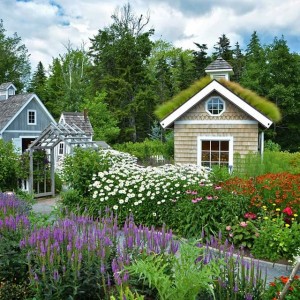By: Grace Brosofsky
Can you make your garden achieve greatness without diverging from principles of sustainability? The Coastal Maine Botanical Gardens provide an example of truly green gardening at its finest, achieving enough popular appeal to draw tourists while making an effort to “protect, preserve, and enhance the botanical heritage and natural landscapes of coastal Maine.” The gardens’ Director of Horticulture, Rodney Eason, did me the honor of sharing some tips of the trade illuminating what it takes to create and manage a sustainable garden.
Soil Conditioning
Rodney believes soil testing can play an important role in maintaining quality grounds. Knowing and adjusting not only the concentrations of different nutrients but also the pH of the soil can help the gardener tremendously. The wrong pH can prevent cation absorption and make plants “starve at the buffet,” unable to take in even nutrients found in abundance.
Rodney both uses liquid organic fertilizers and mixes compost with the soil. He makes sure to screen the compost to “eliminate clumps and clods” and lays it out to “let weed seed germinate” and preclude weed problems later on. He also emphasizes the importance of making sure compost is “treated and aged properly so there aren’t any diseases.”

Rodney’s sustainable gardening artistry in action: the Coastal Maine Botanical Gardens
Managing Pest Problems
According to Rodney, pest problems mainly arise when you “develop a monoculture.” Most pests have a specific host species and can “wipe out” that entire species but not others, so diversity helps prevent pests from destroying a garden by making some plants naturally off-limits.
Rodney also recommends “developing thresholds for integrated pest management” and seeing how much you can manage by hand-picking the pests off the plants before resorting to the usage of toxic pesticides. In addition, he advises looking at the lifecycle of the pest problems to determine a plan of action. Pest problems often start with grubs in turf, so focusing on eliminating the grubs can help manage pests.
Native Plant Usage
Rodney incorporates native plants into the landscape of the Coastal Maine Botanical Gardens, differentiating his domain from other botanical gardens which tend to group all the native plants together in one area and create what Rodney terms a “native plant asylum.” He believes native plants can benefit any area of the garden, noting that visitors would not first note the indigenousness of the plants but that “that’s pretty!” However, he says it’s important to make sure to mix the plants in such a way as to ensure something is always blooming as many plants native to Maine “tend to flower early or late.”
Gardening by Geography
Rodney, who has worked in both Maine and North Carolina, says that gardening in the South involves “more invasive and exotic weeds” like Japanese stiltgrass. While the Northeast still has some exotic weeds such as Mexican climbing bamboo, most weeds tend to have more native origins. From a “growing standpoint,” Maine’s climate allows for planting “pretty much all summer” as temperatures rarely exceed the low 80’s. Rodney says, “Plants grow and don’t close stomata. They aren’t stressed here.”
Vertical Gardening
Rodney believes vertical gardening “will be a bigger and bigger thing,” especially with the shrinking amount of space in cities and the availability of new products such as Wooly Pocket. Referencing his observations of geraniums lining the sides of aged buildings in Spain, he states that vertical gardening “adds a certain aspect that makes the alleyways feel alive.”
Gardening Picks
While Rodney says his favorite plant “changes daily,” if he had to opt for a favorite he would give the honor to the genus of hydrangea. In Rodney’s words, this genus offers “so much diversity” and serves as a “plant show stopper” with “lots of potential for breeding.” As far as his favorite tool, Rodney has found his Felco pruners extremely useful for the past 25 years as there is “always going to be a branch” or something that just might need pruning.
